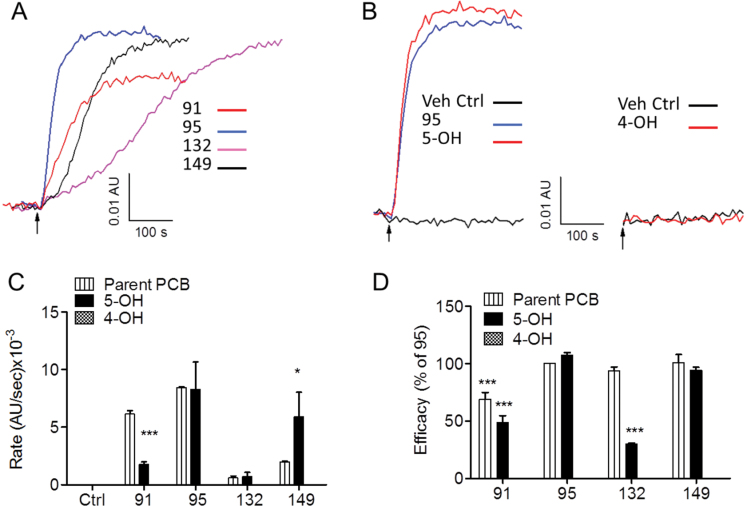FIG. 3.
NDL-PCBs and their 5-OH derivatives trigger Ca2+ release from skeletal SR. A, Representative traces of Ca2+ efflux from skeletal SR membrane vesicles triggered by addition of 4 NDL-PCBs; arrow represents addition of a saturating concentration (10 µM) of each PCB. B, Representative traces of Ca2+ release triggered by 10 µM PCB95 and 5-OH-PCB95 (arrow). Right panel shows that 4-OH-PCB95 failed to trigger Ca2+ release from the SR vesicles. C, Summary of rate of Ca2+ efflux mediated by RyR1 activation (AFU abs/sec) by PCB91, PCB95, PCB132, PCB149, and their 5-OH-derivatives. None of the 4-OH-derivatives tested released Ca2+ from the SR vesicles under the experimental conditions used (see Materials and Methods section). Rates were recorded as changes in arbitrary absorbance units per second, and the bars indicate the mean ± SE of n = 3 experiments using at least 2 different SR membrane preparations. D, The total amount of Ca2+ released from SR vesicles by each NDL-PCB presented as percent of PCB95 (considered a full allosteric RyR1 enhancer). *p < .05; ***p < .001, unpaired t test (comparison of compounds to respective parent PCB); all compounds (excluding 4-OH metabolites) were significantly higher than vehicle control; ***p < .001; one-way ANOVA with Dunnett multiple comparison post hoc test. Note. The same PCB95 trace was used in both panels (A) and (B). Abbreviations: NDL-PCBs, non–dioxin like polychlorinated biphenyls; SR, sarcoplasmic reticulum.

